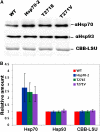ATP requirement for chloroplast protein import is set by the Km for ATP hydrolysis of stromal Hsp70 in Physcomitrella patens
- PMID: 24596240
- PMCID: PMC4001381
- DOI: 10.1105/tpc.113.121822
ATP requirement for chloroplast protein import is set by the Km for ATP hydrolysis of stromal Hsp70 in Physcomitrella patens
Abstract
The 70-kD family of heat shock proteins (Hsp70s) is involved in a number of seemingly disparate cellular functions, including folding of nascent proteins, breakup of misfolded protein aggregates, and translocation of proteins across membranes. They act through the binding and release of substrate proteins, accompanied by hydrolysis of ATP. Chloroplast stromal Hsp70 plays a crucial role in the import of proteins into plastids. Mutations of an ATP binding domain Thr were previously reported to result in an increase in the Km for ATP and a decrease in the enzyme's kcat. To ask which chloroplast stromal chaperone, Hsp70 or Hsp93, both of which are ATPases, dominates the energetics of the motor responsible for protein import, we made transgenic moss (Physcomitrella patens) harboring the Km-altering mutation in the essential stromal Hsp70-2 and measured the effect on the amount of ATP required for protein import into chloroplasts. Here, we report that increasing the Km for ATP hydrolysis of Hsp70 translated into an increased Km for ATP usage by chloroplasts for protein import. This thus directly demonstrates that the ATP-derived energy long known to be required for chloroplast protein import is delivered via the Hsp70 chaperones and that the chaperone's ATPase activity dominates the energetics of the reaction.
Figures








Similar articles
-
A stromal heat shock protein 70 system functions in protein import into chloroplasts in the moss Physcomitrella patens.Plant Cell. 2010 Jan;22(1):205-20. doi: 10.1105/tpc.109.071464. Epub 2010 Jan 8. Plant Cell. 2010. PMID: 20061551 Free PMC article.
-
Molecular chaperone involvement in chloroplast protein import.Biochim Biophys Acta. 2013 Feb;1833(2):332-40. doi: 10.1016/j.bbamcr.2012.03.019. Epub 2012 Apr 12. Biochim Biophys Acta. 2013. PMID: 22521451 Review.
-
Physcomitrella reveals a key role for stromal hsp70 chaperones in chloroplast protein import.Plant Cell. 2010 Jan;22(1):1. doi: 10.1105/tpc.109.220110. Epub 2010 Jan 8. Plant Cell. 2010. PMID: 20061550 Free PMC article. No abstract available.
-
Toc64 is not required for import of proteins into chloroplasts in the moss Physcomitrella patens.Plant J. 2005 Sep;43(5):675-87. doi: 10.1111/j.1365-313X.2005.02483.x. Plant J. 2005. PMID: 16115065
-
Mechanisms of the Hsp70 chaperone system.Biochem Cell Biol. 2010 Apr;88(2):291-300. doi: 10.1139/o09-175. Biochem Cell Biol. 2010. PMID: 20453930 Free PMC article. Review.
Cited by
-
Regulation of Heat Stress in Physcomitrium (Physcomitrella) patens Provides Novel Insight into the Functions of Plant RNase H1s.Int J Mol Sci. 2022 Aug 17;23(16):9270. doi: 10.3390/ijms23169270. Int J Mol Sci. 2022. PMID: 36012542 Free PMC article.
-
Protein import into chloroplasts and its regulation by the ubiquitin-proteasome system.Biochem Soc Trans. 2020 Feb 28;48(1):71-82. doi: 10.1042/BST20190274. Biochem Soc Trans. 2020. PMID: 31922184 Free PMC article. Review.
-
Understanding protein import in diverse non-green plastids.Front Genet. 2023 Mar 16;14:969931. doi: 10.3389/fgene.2023.969931. eCollection 2023. Front Genet. 2023. PMID: 37007964 Free PMC article. Review.
-
Sequence Motifs in Transit Peptides Act as Independent Functional Units and Can Be Transferred to New Sequence Contexts.Plant Physiol. 2015 Sep;169(1):471-84. doi: 10.1104/pp.15.00842. Epub 2015 Jul 6. Plant Physiol. 2015. PMID: 26149569 Free PMC article.
-
GUN control in retrograde signaling: How GENOMES UNCOUPLED proteins adjust nuclear gene expression to plastid biogenesis.Plant Cell. 2021 May 5;33(3):457-474. doi: 10.1093/plcell/koaa048. Plant Cell. 2021. PMID: 33955483 Free PMC article. Review.
References
-
- Alder N.N., Theg S.M. (2003). Protein transport via the cpTat pathway displays cooperativity and is stimulated by transport-incompetent substrate. FEBS Lett. 540: 96–100. - PubMed
-
- Aronsson H., Jarvis P. (2002). A simple method for isolating import-competent Arabidopsis chloroplasts. FEBS Lett. 529: 215–220. - PubMed
-
- Bagola K., Mehnert M., Jarosch E., Sommer T. (2011). Protein dislocation from the ER. Biochim. Biophys. Acta 1808: 925–936. - PubMed
-
- Becker T., Böttinger L., Pfanner N. (2012). Mitochondrial protein import: From transport pathways to an integrated network. Trends Biochem. Sci. 37: 85–91. - PubMed
Publication types
MeSH terms
Substances
LinkOut - more resources
Full Text Sources
Other Literature Sources

